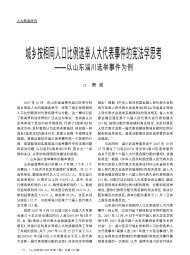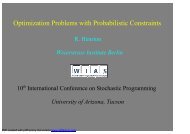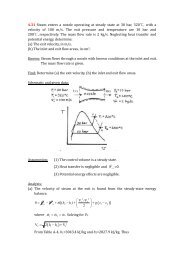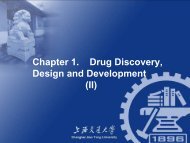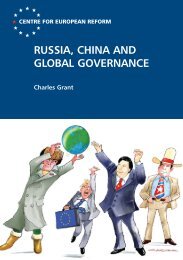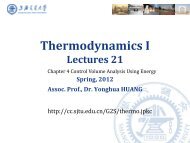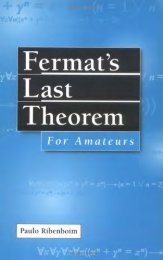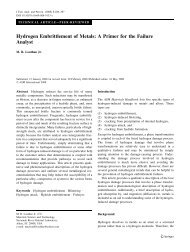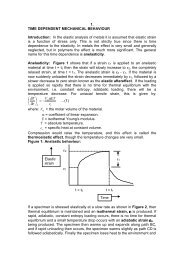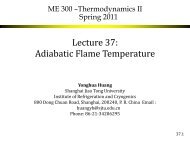The Making of the Apartheid Plan, 1929-1948* - CC
The Making of the Apartheid Plan, 1929-1948* - CC
The Making of the Apartheid Plan, 1929-1948* - CC
Create successful ePaper yourself
Turn your PDF publications into a flip-book with our unique Google optimized e-Paper software.
374 Journal <strong>of</strong> Sou<strong>the</strong>rn African Studies<br />
Downloaded by [Shanghai Jiaotong University] at 18:42 19 September 2012<br />
Orange Free State, he addressed a DRC conference on <strong>the</strong> ‘native question’ held in<br />
Kroonstad in <strong>the</strong> province. Rejecting a missions policy that <strong>of</strong>fered blacks no ‘independent<br />
national future’, he pleaded for <strong>the</strong> Gospel to be brought in a way that fitted <strong>the</strong> African<br />
‘character, nature and nationality’. He said, ‘In <strong>the</strong> fundamental idea <strong>of</strong> our missionary work<br />
and not in racial prejudice one must seek an explanation for <strong>the</strong> spirit <strong>of</strong> apar<strong>the</strong>id that has<br />
always characterised our [<strong>the</strong> DRC’s] conduct.’ 3<br />
It was only in <strong>the</strong> early 1940s that <strong>the</strong> idea <strong>of</strong> apar<strong>the</strong>id became crystallised. Die Burger<br />
first used <strong>the</strong> term ‘apar<strong>the</strong>id’ in 1943 when it referred to <strong>the</strong> ‘accepted Afrikaner viewpoint<br />
<strong>of</strong> apar<strong>the</strong>id’. 4 In January 1944, D. F. Malan, speaking as Leader <strong>of</strong> <strong>the</strong> Opposition, became<br />
<strong>the</strong> first person to employ it in <strong>the</strong> South African parliament. A few months later he<br />
elaborated, ‘I do not use <strong>the</strong> term “segregation”, because it has been interpreted as a fencing<br />
<strong>of</strong>f (afhok), but ra<strong>the</strong>r “apar<strong>the</strong>id”, which will give <strong>the</strong> various races <strong>the</strong> opportunity <strong>of</strong><br />
uplifting <strong>the</strong>mselves on <strong>the</strong> basis <strong>of</strong> what is <strong>the</strong>ir own.’ 5<br />
<strong>The</strong>re also exists no consensus on what <strong>the</strong> policy represents in <strong>the</strong> larger scheme <strong>of</strong><br />
things. Was it simply an extension <strong>of</strong> <strong>the</strong> ‘traditional’ policy <strong>of</strong> segregation and a marginal<br />
refinement <strong>of</strong> <strong>the</strong> racial ideology that justified segregation? Was it a modern ideology<br />
justifying Afrikaner domination in an era <strong>of</strong> decolonisation? Or was it something deviant<br />
that appealed to <strong>the</strong> same racist obsessions as those <strong>of</strong> <strong>the</strong> Nazis and to a heretical<br />
interpretation <strong>of</strong> <strong>the</strong> Bible never used before?<br />
Shortly after <strong>the</strong> 1948 election, Keppel-Jones, a young liberal historian, unequivocally<br />
declared that apar<strong>the</strong>id was simply a warmed-up version <strong>of</strong> segregation. ‘One <strong>of</strong> <strong>the</strong><br />
psychological curiosities <strong>of</strong> our history is <strong>the</strong> sudden substitution <strong>of</strong> <strong>the</strong> word apar<strong>the</strong>id for<br />
<strong>the</strong> word segregation, which means <strong>the</strong> same thing.’ It was a case <strong>of</strong> ‘same firm, same<br />
product, new label’. 6 More than 50 years later, a general history expressed almost <strong>the</strong> same<br />
opinion: ‘It was really an elaboration <strong>of</strong> earlier segregationist traditions derived partly from<br />
Stallardism, partly from <strong>the</strong> thinking <strong>of</strong> Broederbond circles in <strong>the</strong> 1930s.’ 7 Legassick<br />
proposed a variation on <strong>the</strong> <strong>the</strong>me in suggesting that apar<strong>the</strong>id was an adaptation <strong>of</strong> <strong>the</strong><br />
traditional labour policy and practices to an economy whose base had shifted from mining<br />
to manufacturing. 8 O’Meara argues that apar<strong>the</strong>id developed as a plan to secure a stable and<br />
cheap labour supply for farmers and <strong>the</strong> emerging classes <strong>of</strong> Afrikaner capitalists. 9 Posel’s<br />
work opened up a new perspective in depicting apar<strong>the</strong>id as a policy and ideology largely<br />
shaped by post-1948 struggles within <strong>the</strong> Nationalist movement. 10 But she, too, see conflicts<br />
over <strong>the</strong> labour supply and influx control as <strong>of</strong> paramount importance ra<strong>the</strong>r than <strong>the</strong> quest<br />
to find a justification for Afrikaner political domination.<br />
<strong>The</strong> analysis by Gregor was one <strong>of</strong> <strong>the</strong> first to project apar<strong>the</strong>id as a novel, post-Second<br />
World War ideology that went well beyond a justification for labour control in <strong>the</strong> specific<br />
South African circumstances. Written in <strong>the</strong> mid-1960s as part <strong>of</strong> a study <strong>of</strong> radical<br />
ideologies, it depicted apar<strong>the</strong>id as a secular social and political ideology typical <strong>of</strong> <strong>the</strong><br />
twentieth century. ‘It advances its own normic model <strong>of</strong> man and society; defends its<br />
3 ‘Dawie’, Die Burger’s columnist, discussed <strong>the</strong> issue on 24 March and 14 April 1951. <strong>The</strong> speech is published<br />
as ‘Die Ideale van ons Kerk in Sendingwerk’, Die NG Kerk en die Naturellevraagstuk (Bloemfontein, Nasionale<br />
Pers, <strong>1929</strong>), pp. 22–25. I wish to thank Rick Elphick for pointing me to <strong>the</strong> document.<br />
4L.Louw (compiler), Dawie, 1946–1964 (Cape Town, Tafelberg, 1965), p. 49.<br />
5 House <strong>of</strong> Assembly Debates (HAD), 1944, col. 75; Die Burger, 8May 1944; Louw, Dawie, p.48.<br />
6A.Keppel-Jones, Friends or Foes? (Pietermaritzburg, Shuter and Shooter, 1949), p. 48.<br />
7 Davenport and Saunders, South Africa, p.373.<br />
8M.Legassick, ‘Legislation, Ideology and Economy in post—1948 South Africa’, Journal <strong>of</strong> Sou<strong>the</strong>rn African<br />
Studies, 1,1(1974), pp. 9–10.<br />
9D.O’Meara, Volkskapitalisme: Class, Capital and Ideology in <strong>the</strong> Development <strong>of</strong> Afrikaner Nationalism,<br />
1934–1948 (Cambridge, Cambridge University Press, 1983), pp. 171–177.<br />
10 D. Posel, <strong>The</strong> <strong>Making</strong> <strong>of</strong> Apar<strong>the</strong>id (Oxford, Clarendon Press, 1997).



